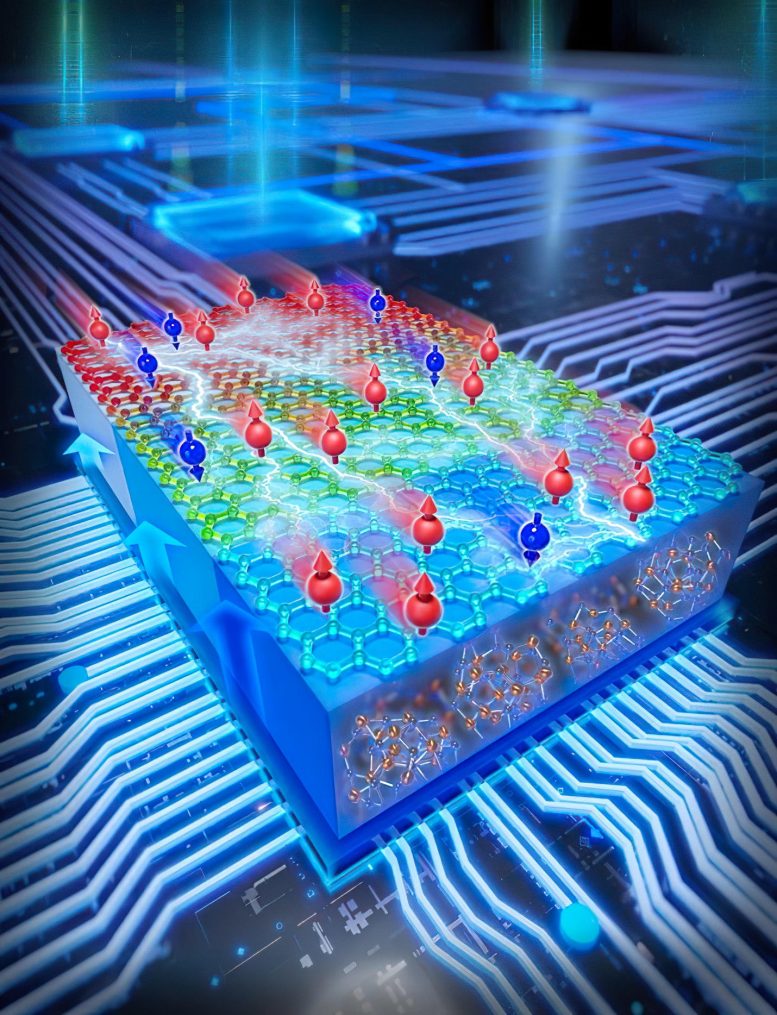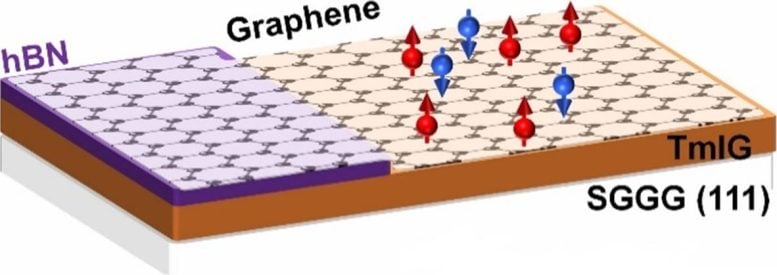
The NUS researchers demonstrated the emergence of robust spin-polarisation in graphene on a ferrimagnetic insulating oxide Tm3Fe5O12 (TmIG) with large spin-splitting energy of up to hundreds of meV. The observed spin polarisation in graphene with large and tunable spin-splitting energy holds great promise for promises the field of 2D spintronics for low-power electronics. Credit: National University of Singapore
Physicists at the National University of Singapore have innovated a concept to induce and directly quantify spin splitting in two-dimensional materials. By using this concept, they have experimentally achieved large tunability and a high degree of spin-polarisation in <span class="glossaryLink" aria-describedby="tt" data-cmtooltip="
” data-gt-translate-attributes=”[{"attribute":"data-cmtooltip", "format":"html"}]” tabindex=”0″ role=”link”>graphene. This research achievement can potentially advance the field of two-dimensional (2D) spintronics, with applications for low-power electronics.
Joule heating poses a significant challenge in modern electronics, especially in devices such as personal computers and smartphones. This is an effect that occurs when the flow of electrical current passing through a material produces thermal energy, subsequently raising the material’s temperature.
One potential solution involves the use of spin, instead of charge, in logic circuits. These circuits can, in principle, offer low-power consumption and ultrafast speed, owing to the reduction or elimination of Joule heating. This has given rise to the emerging field of spintronics.
Graphene is an ideal 2D material for spintronics, due to its long spin diffusion length and long spin lifetime even at room temperature. Even though graphene is not inherently spin-polarised, it can be induced to exhibit spin-splitting behavior by placing it near magnetic materials. However, there are two main challenges. There is a lack of direct methods for determining the spin-splitting energy and a limitation in graphene’s spin properties and tunability.
Breakthrough in Graphene Spintronics
A research team led by Professor Ariando from the NUS Department of Physics developed an innovative concept to directly quantify spin-splitting energy in magnetic graphene using the Landau fan shift. Landau fan shift refers to the shift of intercept when plotting linear fits of oscillation frequency with charge carriers, which is due to the splitting of energy levels of charged particles in a magnetic field. It can be used to study the fundamental properties of matter.

Figure showing the diffusion of spin-polarised electrons within a graphene layer placed on top of a ferrimagnetic insulating oxide Tm3Fe5O12 (TmIG). The strong exchange interaction between the graphene and TmIG results in a significant spin splitting of the graphene band structure. This spin splitting, in turn, results in a substantial difference in the density of charge carriers with spin orientations labeled as “spin up” (↑) and “spin down” (↓). This difference in carrier density gives rise to the generation of a spin-polarised current. Credit: Advanced Materials
Moreover, the induced spin-splitting energy can be tuned over a broad range by a technique called field cooling. The observed high spin polarisation in graphene, coupled with its tunability in spin-splitting energy, offers a promising avenue for the development of 2D spintronics for low-power electronics.
The findings were recently published in the journal Advanced Materials.
Experimental Validation and Theoretical Support
The researchers performed a series of experiments to validate their approach. They began by creating a magnetic graphene structure by stacking a monolayer graphene on top of a magnetic insulating oxide Tm3
To further corroborate the direct relationship between the Landau fan shift and spin-splitting energy, the researchers performed field cooling experiments to tune the degree of spin-splitting in graphene. They also applied X-ray magnetic circular dichroism at the Singapore Synchrotron Light Source to reveal the origins of the spin-polarisation.
Dr Junxiong HU, Senior Research Fellow at the NUS Department of Physics and the lead author for the research paper, said, “Our work solves the long-standing controversy in 2D spintronics, by developing a concept that uses the Landau fan shift to directly quantify the spin splitting in magnetic materials.”
To further support their experimental findings, the researchers collaborated with a theoretical team led by Professor Zhenhua QIAO from the University of Science and Technology of China, to calculate the spin-splitting energy using first principle calculations.
The theoretical results obtained were consistent with their experimental data. Moreover, they also used <span class="glossaryLink" aria-describedby="tt" data-cmtooltip="
” data-gt-translate-attributes=”[{"attribute":"data-cmtooltip", "format":"html"}]” tabindex=”0″ role=”link”>machine learning to fit their experimental data based on a phenomenological model, which provides a deeper understanding of the tunability of spin-splitting energy by field cooling.
Prof Ariando said, “Our work develops a robust and unique route to generate, detect, and manipulate the spin of electrons in atomically thin materials. It also demonstrates the practical use of artificial intelligence in materials science. With the rapid development and significant interest in the field of 2D magnets and stacking-induced magnetism in atomically thin van der Waals heterostructures, we believe our results can be extended to various other 2D magnetic systems.”
Building upon this proof-of-concept study, the research team plans to explore the manipulation of spin current at room temperature. Their goal is to apply their findings in the development of 2D spin-logic circuitry and magnetic memory/sensory devices. The ability to efficiently tune the spin polarisation of current forms the basis for the realization of an all-electric spin field-effect transistors, ushering in a new era of low-power consumption and ultrafast-speed electronics.
Reference: “Tunable Spin-Polarized States in Graphene on a Ferrimagnetic Oxide Insulator” by Junxiong Hu, Yulei Han, Xiao Chi, Ganesh Ji Omar, Mohammed Mohammed Esmail Al Ezzi, Jian Gou, Xiaojiang Yu, Rusydi Andrivo, Kenji Watanabe, Takashi Taniguchi, Andrew Thye Shen Wee, Zhenhua Qiao and A. Ariando, 9 October 2023, Advanced Materials.
DOI: 10.1002/adma.202305763
